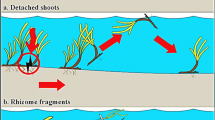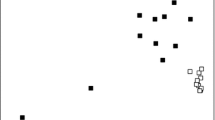Abstract
Recolonization dynamics from disturbance on a Philippine mixed seagrass meadow, containing species spanning more than 10-fold in rhizome elongation rates and reproductive effort, was examined by following the recovery of a 1,200 m2 gap over 2.5 yr. The objective was to assess the contribution of contrasting species to the recovery process and to evaluate the importance of sexual versus vegetative colonization. Large, slow-growing species,Thalassia hemprichii andEnhalus acoroides, that produce large, broadly-dispersed seeds dominated sexual colonization with a total of 2,643 and 210 seedlings, respectively, recruiting to the area. Despite very rapid turnover of sexual recruits, the high frequency of seedling establishment ensured successful development of new patches in areas devoid of vegetation, leading to a scattered and evenly distributed presence of vegetation inside the gap. The small seagrass speciesCymodocea rotundata andHalodule uninervis, characterized by fast rhizome elongation rates but low reproductive output and limited seed dispersal, were the major contributors to the overall 450 m2 increase in vegetation cover through fast lateral extension (144±6 cm yr−1) from meadow edge and surviving patches, forming a compact vegetation cover in one edge of the denuded area. We conclude that contrasting recruitment strategies in the mixed-species seagrass community examined have implications for colonization potential at different spatial scales. Fast clonal growth is only an efficient mechanism for colonization of disturbances within established meadows (small gaps), whereas the large species, which combined high reproductive output with high seed dispersal capacity, may act to accelerate the colonization process in large gaps or distant from established meadows.
Similar content being viewed by others
Literature Cited
Begon, M., J. L. Harper andC. R. Townsend. 1996. Ecology, Individuals, Populations and Communities. Blackwell Science, Oxford, U.K.
Bell, S. S., B. D. Robbins, andS. L. Jensen. 1999. Gap dynamics in a seagrass landscape.Ecosystems 2:493–504.
Birch, W. R. andM. Birch. 1984. Succession and pattern of tropical intertidal seagrasses in Cocle Bay, Queensland, Australia: A decade of observations.Aquatic Botany 19:343–367.
Brouns, J. J. W. M. 1987. Growth patterns in some Indo-West-Pacific seagrasses.Aquatic Botany 28:39–61.
Churchill, A. C. 1983. Field studies on seed germination and seedling development inZostera marina L.Aquatic Botany 16: 21–29.
den Hartog, C. 1970. The Sea-Grasses of the World. North-Holland Publication Co., Amsterdam, The Netherlands.
den Hartog, C. 1971. The dynamic aspect, in the ecology of seagrass communities.Thalassia Jugoslavica 7:101–112.
Duarte, C. M. 1991. Allometric scaling of seagrass form and productivity.Marine Ecology Progress Series 77:289–300.
Duarte, C. M. 2001. Seagrasses, p. 254–268.In S. L. Levin (ed.), Encyclopedia of Biodiversity, Volume 5. Academic Press, San Diego, California.
Duarte, C. M. andK. Sand-Jensen. 1990. Seagrass colonization: Patch formation and patch growth inCymodocea nodosa.Marine Ecology Progress Series 65:193–200.
Duarte, C. M. andK. Sand-Jensen. 1996. Nutrient constraints on establishment from seed and on vegetative expansion of the Mediterranean seagrassCymodocea nodosa.Aquatic Botany 54:279–286.
Duarte, C. M., J. Terrados, N. S. R. Agawin, M. D. Fortes, S. Bach, andW. J. Kenworthy. 1997a. Response of a mixed Philippine seagrass meadow to experimental burial.Marine Ecology Progress Series 147:285–294.
Duarte, C. M., J. Terrados, N. S. R. Agawin, andM. D. Fortes. 2000. An experimental test of the occurrence of competitive interactions among SE Asian seagrasses.Marine Ecology Progress Series 197:231–240.
Duarte, C. M., J. S. Uri, N. S. R. Agawin, M. D. Fortes, J. E. Vermaat, andN. Marba. 1997b. Flowering frequency of Philippine seagrasses.Botanica Marina 40:497–500.
Fahrig, L., D. P. Coffin, W. K. Lauenroth, andH. H. Shugart. 1994. The advantage of long-distance clonal spreading in highly disturbed habitats.Evolutionary Ecology 8:172–187.
Fonseca, M. S. andS. S. Bell. 1998. Influence of physical setting on seagrass landscapes near Beaufort, North Carolina, USA.Marine Ecology Progress Series 171:109–121.
Fonseca, M. S., W. J. Kenworthy andP. E. Whitfield. 2000. Temporal dynamics of seagrass landscapes: A preliminary comparison of chronic and extreme disturbance events, p. 373–376.In G. Pergent, C. Pergent-Martini, M. C. Buia, and M. C. Gambi (eds.), Proceedings of the Fourth International Seagrass Biology Workshop, September 25–October 2, 2000, Corsica, France. Biologia Marina Mediterranea, Instituto di Zoologia, Genova, Italy.
Fonseca, M. S., J. C. Zieman, G. W. Thayer, andJ. S. Fisher. 1983. The role of current velocity in structuring eelgrass (Zostera marina L.) meadows.Estuarine Coastal and Shelf Science 17: 367–380.
Harrison, P. G. 1993. Variations in demography ofZostera marina andZ. noltii on an intertidal gradient.Aquatic Botany 45: 63–77.
Hemminga, M. A. andC. M. Duarte. 2000. Seagrass Ecology. Cambridge University Press, Cambridge, U.K.
Inglis, G. J. 2000a. Variation in the recruitment behaviour of seagrass seeds: Implications for population dynamics and resource management.Pacific Conservation Biology 5:251–259.
Inglis, G. J. 2000b. Disturbance-related heterogeneity in seed banks of a marine angiosperm.Journal of Ecology 88:88–99.
Kaldy, J. E. andK. H. Dunton. 1999. Ontogenetic photosynthetic changes, dispersal and survival ofThalassia testudinum (turtle grass) seedlings in a sub-tropical lagoon.Journal of Marine Biology and Ecology 240:193–212.
Kendall M. S., T. Battista, andZ. Hillis-Starr. 2004. Long term expansion of a deepSyringodium filiforme, meadow in St. Croix, U.S. Virgin Islands: The potential role of hurricanes in the dispersal of seeds.Aquatic Botany 78:15–25.
Kenworthy, W. J. 2000. The role of sexual reproduction in maintaining populations ofHalophila decipiens: Implications for the biodiversity and conservation of tropical ecosystems.Pacific Conservation Biology 5:260–268.
Kirkman, H. 1985. Community structure in seagrasses in south Western Australia.Aquatic Botany 21:363–375.
Kirkman, H. andJ. Kuo. 1990. Pattern and process in southern Western Australian seagrasses.Aquatic Botany 37:367–382.
Lacap, C. D. A., J. E. Vermaat, R. N. Rollon, andH. M. Nacorda. 2002. Propagule dispersal of the SE Asian seagrassesEnhalus acoroides andThalassia hemprichii.Marine Ecology Progress Series 235:75–80.
Marba, N. andC. M. Duarte. 1998. Rhizome elongation and seagrass clonal growth.Marine Ecology Progress Series 174:269–280.
McMillan, C. K. 1981. Seed reserves and seed germination for two seagrasses,Halodule wrightii andSyringodium filiforme, from the Western Atlantic.Aquatic Botany 11:279–296.
McMillan, C., K. W. Bridges, R. L. Kock, andM. Falanruw. 1982. Fruit and seedlings ofCymodocea rotundata in Yap, Micronesia.Aquatic Botany 14:99–105.
Nakaoka, M. andK. Aioi. 1999. Growth of seagrassHalophila ovalis at dugong trails compared to existing within-patch variation in a Thailand intertidal flat.Marine Ecology Progress Series 184:97–103.
Olesen, B. andK. Sand-jensen. 1994. Patch dynamics of eelgrassZostera marina.Marine Ecology Progress Series 106:147–156.
Orth, R. J., M. C. Harwell, E. M. Bailey, A. Bartholomew, J. T. J. Jawad, A. V. Lombana, K. A. Moore, J. M. Rhode, andH. E. Woods. 2000. A review of issues in seagrass seed dormancy and germination: Implications for conservation and restoration.Marine Ecology Progress Series 200:277–288.
Patriquin, D. G. 1975. “Migration” of blowouts in seagrass beds at Barbados and Carriacou, West Indies, and its ecological and geological implications.Aquatic Botany 1:163–189.
Pickett, S. T. A. andP. S. White. 1985. The ecology of natural disturbance and patch dynamics. Academic Press, Orlando, Florida.
Poiner, I. R., D. I. Walker, andR. G. Coles. 1989. Regional studies: Seagrasses of tropical Australia, p. 279–303.In A. W. D. Larkum, A. J. McComb, and S. A. Shepherd (eds.), Biology of Seagrasses: A Treatise on the Biology of Seagrasses with Special Reference to the Australian Region. Elsevier, Amsterdam, The Netherlands.
Preen, A. 1995. Impact of dugong foraging on seagrass habitats: Observational and experimental evidence for cultivation grazing.Marine Ecology Progress Series 124:201–213.
Preen, A. R., W. J. Lee Long, andR. G. Coles. 1995. Flood and cyclone related loss, and partial recovery, of more than 1000 km2 of seagrass in Harvey Bay, Queensland, Australia.Aquatic Botany 52:3–17.
Ramage, D. L. andD. R. Schiel. 1999. Patch dynamics and response to disturbance of the seagrassZostera novazelandica on intertidal platforms in southern New Zealand.Marine Ecology Progress Series 189:275–288.
Rasheed, M. A. 1999. Recovery of experimentally created gaps within a tropicalZostera capricorini (Aschers) seagrass meadow, Queensland, Australia.Journal of Marine Biology and Ecology 235:183–200.
Rollon, R. N., E. D. D. R. van Steveninck, W. van Vierssen, andM. D. Fortes. 1998. Contrasting recolonization strategies in multi-species seagrass meadows.Marine Pollution Bulletin 37: 450–459.
Rollon, R. N., J. E. Vermaat, andH. M. E. Nacorda. 2003. Sexual reproduction in SE Asian seagrasses: The absence of a seed bank inThalassia hemprichii.Aquatic Botany 75:181–185.
Sousa, W. P. 1984. The role of disturbance in natural communities.Annual Review of Ecology and Systematics 15:353–391.
Terrados, J. 1993. Sexual reproduction and seed banks ofCymodocea nodosa (Ucria) Ascherson meadows on the southeast Mediterranean coast of Spain.Aquatic Botany 46:293–299.
Tillman, D. 1994. Competition and biodiversity in spatially structured habitats.Ecology 75:2–16.
Vermaat, J. E., N. S. R. Agawin, C. M. Duarte, M. D. Fortes, N. Marbà, andJ. S. Uri. 1995. Meadow maintenance, growth and productivity of a mixed Philippine seagrass bed.Marine Ecology Progress Series 124:215–225.
Walker, D. I., W. C. Dennison, andG. Edgar. 1999. Status of Australian seagrass research and knowledge, p. 1–24.In A. J. Butler (ed.), Seagrass in Australia: Strategic Review and Development of an R & D Plan. CSIRO Publishing, Australia.
Whitfield, P. A., W. J. Kenworthy, M. J. Durako, K. K. Hammerstrom, andM. F. Merello. 2004. Recruitment ofThalassia testudinum seedlings into physically disturbed seagrass beds.Marine Ecology Progress Series 267:121–131.
Williams, S. L. 1990. Experimental studies of Caribbean seagrass bed development.Ecological Monographs 60:449–469.
Author information
Authors and Affiliations
Corresponding author
Rights and permissions
About this article
Cite this article
Olesen, B., Marba, N., Duarte, C.M. et al. Recolonization dynamics in a mixed seagrass meadow: The role of clonal versus sexual processes. Estuaries 27, 770–780 (2004). https://doi.org/10.1007/BF02912039
Received:
Revised:
Accepted:
Issue Date:
DOI: https://doi.org/10.1007/BF02912039




